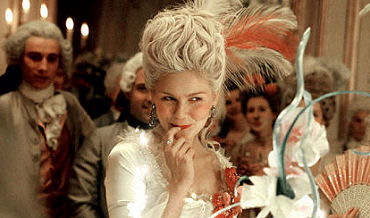If you want to read a well-written article that indirectly tells you what’s profoundly unsatisfying about Sofia Coppola’s Marie-Antoinette (Columbia, 10.20), read this Vogue/Style.com piece by the respected writer and journalism professor Kennedy Fraser.

It’s been edited down from a longer version that appears in the pages on the September issue of Vogue, and I can’t imagine that Fraser would be very happy with it. It’s 21 paragraphs long — two introductory graphs about Coppola and her thoughts about what she focused in the film, and then, dropping all pretense of being any kind of behind-the-curtain piece, it turns into a mini-biography of the Austrian queen (Kirsten Dunst).
Here’s the thing: graphs #3 through #15 cover the story told in the film, the fourteenth graph tells what most likely happened when an angry crowd stormed the Versailles palace in 1789 (Fraser and Coppola differ significantly in their respctive tellings), and the last five graphs cover Antoninette’s life from late 1789 until her death by guillotine in October 1793.
Read the piece (or better yet, read this Wikipedia biography) and tell me the last four years of Marie-Antoinette’s life weren’t far more intriguing than the previous 33. Coppola’s film ignores ’89 to ’93, of course. She brings her film to a close just as things are starting to get interesting.
The odd part is that Fraser’s piece doesn’t mention that Coppola’s fillm focuses on the earlier, fluffier, less character-defining aspects of her life — that she’s made, as I put it last May, “arguably the shallowest and dullest historical biopic of all time.”
